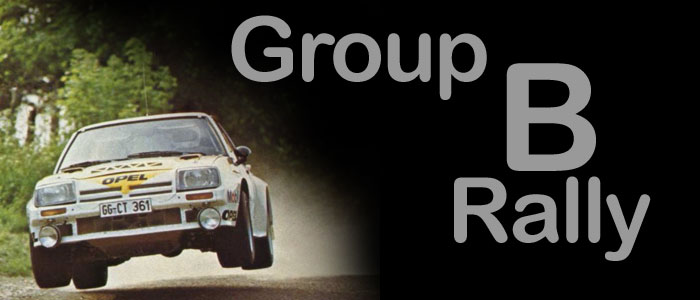Lanica Beta Montecarlo "037" (1983)

- Homologation: 1.4.1982 (B210)
- Weight: 960 kg (2116 lbs)
- Mid Engine (Longitudinal), RWD
- Engine: 1995cc Inline 4 cylinder
- Bore: 84mm
- Stroke: 90mm
- Compression: 7.5:1
- Head: DOHC 16 Valve
- Fuel: Bosch
- Power: 280hp @ 8000 rpm
- Torque: 200 ft/lbs @ 5000 rpm
- Induction: Forced (Roots Supercharger - .6-.9 bar boost)
- Engine: 2111cc Inline 4 cylinder
- Bore: 86.5mm
- Stroke: 90mm
- Compression Ratio: 9:1
- Head: DOHC 16 Valve
- Fuel: Bosch
- Power: 345hp @ 8000 rpm
- Torque: 217 ft/lbs @ 5500 rpm
- Induction: Forced (Roots Supercharger - 1 bar boost)
www.lanciarally037.com
The first official Group B rally car was the Lancia 037, introduced in 1983, to take advantage of the liberal rules permitted by the new Group B category. The 037 was designed as a rear-wheel-drive car, because of the uncertainty surrounding Audi's four-wheel-drive experiment. The 325-horsepower 037 was a superb tarmac car, and it was more reliable than the Quattro, so drivers Walter Röhrl and Markku Alen brought Lancia the constructor's crown in its debut season. However, advancing technology rapidly rendered the 037 obsolete; in 1984, it was already showing its age. In its final rallies, the 037 was running Formula 1 qualifying compound tires on tarmac stages. Most of the time that was made up was lost becuase the soft compound tires needing to be changed during "pit stops" mid stage!

Lancia Delta S4 (1985)

- Homologation: 1.11.1985 (B276)
- Weight: 1200 kg (2646 lbs)
- Mid Engine (Longitudinal), AWD, Tubular Spaceframe
- Top Speed: 140 mph
- Engine: 1759cc Inline 4 cylinder
- Bore: 88.5 mm
- Stroke: 71.5 mm
- Compression: 7.0:1
- Head: DOHC 16 Valve
- Fuel: Weber-Magneti Marelli
- Induction: Forced (KKK Turbo & Roots Supercharger)
- Power: 450 hp @ 8000 rpm
- Torque: 333 ft/lbs. @ 5000 rpm
With the 037 quickly dropping down the leader board, the Lancia / Abarth team was pinning their hopes on the new Delta S4, which was set to make its introduction late in the 1985 season. The team was not to be disappointed. The S4, one of the most advanced cars yet seen. The twin-charged engine was one of the first turbo AND supercharged engines. The goal was to provide maximum boost at all RPM ranges with a resulting flat torque curve through out powerband. The complex system, developed in association with Abarth, used a supercharger to provide most of the boost at lower RPM (because a turbo suffers from lag at lower engine speeds), and a turbocharger pressurized the engine at higher RPMs (because a supercharger is less efficient at higher RPMs). The 500+ hp engine took time to perfect, but the results were worth waiting for. Lancia and Abarth managed to successfully synchronize the twincharging, so there was a smooth transition from one to the other.
Markku Alen and Henri Toivonen were bestowed with the honour of driving for the Lancia factory during the 1986 season. The first rally contested by the S4, the 1985 RAC rally, was a very convincing 1-2 finish for the team, with young Toivonen receiving the first place trophy. Lancia started the 1986 season in the same fashion as they concluded the 1985 season, but the death of Toivonen in Corsica was a devastation to the team, and to the entire rally community. Lancia lost the 1986 titles after a hard-fought battle with Peugeot, but the S4 did win the 1986 European championship in the hands of Fabrizio Tabaton. It was, however, a hollow victory following Toivonen's death.

Info copied from: www.lanciaaustralia.com.au
Lancia ECV1 (Group S Prototype)

First displayed at the Bologna Motorshow in 1986, the ECV1 (Experimental Composite Vehicle) was a composite technology concept car testing the use of carbon, kevlar, thermosetting and thermoplastic resins, glassfibre and honeycomb in car production. It was also considered Lancia's prototype Group S car (a formula which never came to fruit). It was a further development of the S4, featuring the same basic design, with many of the components now made from composites, including the main, load bearing part of the body. Other composite parts included the wheels (8x16" wheels weighing only 6kg !) and the propshaft. It was powered by a 1759cc twin turbo (two KKK units) engine producing 600bhp @ 8,000rpm using a new design known as "triflux" where the two turbochargers were used sequentially depending on the engine speed. An overall weight of 930kg was achieved.
The 1800cc power unit of the ECV1 & 2 was known as the triflux. This was due to the design which had one exhaust and one inlet valve on each side of the cylinder head, with the resulting twin exhaust manifolds each feeding one turbocharger. At low engine speeds one turbocharger exhaust was shut-off, forcing all the exhaust gases through one unit and thus providing good low speed performance. As the engine speed rose, the second turbocharger was gradually introduced, until at high engine speeds both turbochargers ran in parallel.
Lancia EVC2

The ECV2 was a further development of the theme, with an all new bodywork which was aerodynamically optimised, the major change being the relocation of the engine coolant and lubricant radiators to the front of the car. The body construction continued the theme of the ECV1, using aluminium honeycomb, carbon fibre, glass fibre and kevlar in various positions. The weight distribution was also improved with respect to the previous model. The engine remained 1759cc with two turbochargers using the triflux system. The intercoolers also adopted water cooling. The drive system remained essentially as in the S4, with some improvements, a three-differential design with 30% of the torque at the front and the remaining 70% at the rear. Ventilated disc brakes, power assisted steering and double wishbone suspension all round were also used. The wheelbase was 2440mm, the tracks (front/rear) 1500mm/1520mm and kerb weight 910kg.
